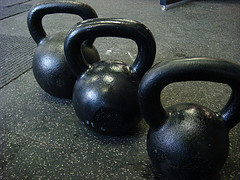Olympic Lifts and Foundatations
By Wil Fleming
Coaches everywhere, and a great percentage of coaches at that, choose to use some type of Olympic lifts in their training of athletes. Typically this Olympic lift is a power clean, starting from the floor. While this is appropriate for plenty of athletes, there are multiple variations in the starting position, that it can be hard to determine which is the right place to start.
In Part 1 I discussed the advantages and disadvantages of the floor start position and the block start position. In Part 2 you will learn about 2 of the more popular hang start positions.
So lets take a look at the advantages and disadvantages of some of the Olympic lifts variations in start position.
Hang Start Position (High Thigh)
The hang position with the bar on the high thigh is a very popular way to start for both athletes and in training for competition weightlifters. This position is actually the one that is taught in many certification courses as a great way to train beginners on the lifts.
The start position is usually ½ way or more up to the top of the thigh but below the hip crease. The start position is nearly at the finish of the 2nd pull and will lead to a very quick and explosive lift.
Pros: This start position is excellent for training athletes to become more proficient at the Olympic lifts. The start position is relatively easy to attain because the counter movement is short which makes it hard to miss. Due to the high nature of the start position the speed of the lift is very quick making coaching cues simple, (“explode”, “Drive” etc,). As a technique tool it reinforces the 2nd pull and even assists in making the athlete more efficient at the 3rd pull, more so than any other start position for the Olympic lifts.
Cons: This is a great place to start. In my experience though many athletes have a difficult time generating much power from this start position early on. Technical difficulties for novice athletes from this position are usually things like, jerking their head back from the start, or over scooping the knees forward to initiate the movement. The correct start position is fairly quad dominant and doesn’t rely as much on the athlete’s ability to extend the hips as other hang start positions. As with other hang start positions multiple reps are difficult on the grip (not that big of a con, but still needs to be mentioned).
Hang Start Position (Above Knee)
This is a common position to see athletes do cleans and snatches. In fact, this is the primary position from which I teach my athletes how to clean or snatch. The start position is directly above the knee cap (or 3-4 inches above in the snatch).
Pros: This start position is easy to attain for most athletes, it mimics the pattern that they will go through when you ask them to jump as high as possible. The easy to attain start position and similarity to other athletic movement means that athletes will have early success with the lift. In terms of training this usually means that the athlete will be able to lift more weight, correctly, and sooner than with other positions. One big positive with this lift is that athletes are made to assume a more hip dominant position to start, training the posterior chain more effectively than hang start positions higher on the thigh.
Cons: Because the position is lower on the thigh, athletes that are extremely quad dominant in their movements have difficulty getting to the start position. Often times they will try to squat, or knee bend their way to the start. Athletes that lack lumbar and core stability will try to achieve the start position through a back bend. The longer counter movement actually makes grip even more of an issue than some shorter hang start positions.
Many pros and cons lists end up with a verdict, but with the Olympic lifts I cannot form one. All of the lifts have benefits and drawbacks, and some more so than others. Take the considerations in the last two articles to mind when training with the lifts and test each of them out for yourself and those athletes that are ready.
Missed part 1? Click here




